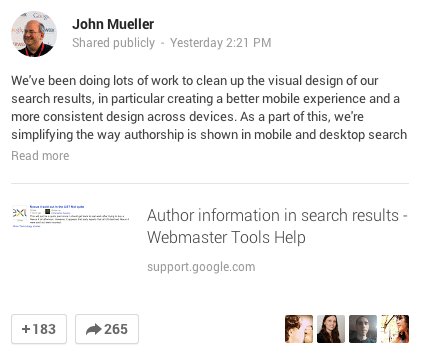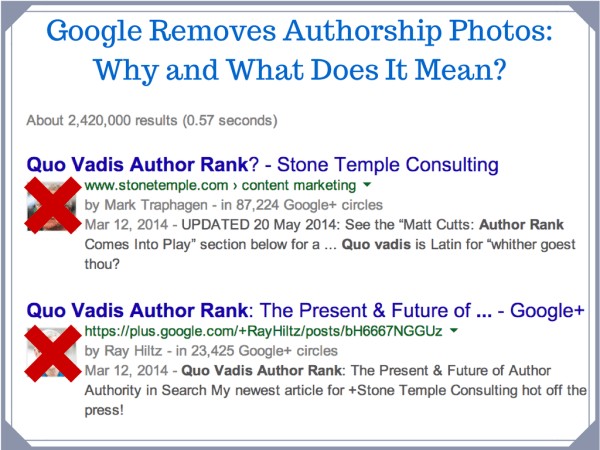Google Removes Author Photos From Search: Why And What Does It Mean?
The search world was rocked by yesterday’s announcement by Google’s Webmaster trends analyst John Mueller that Google will be removing all author photos and Google+ view counts from search results on both desktop and mobile. This change will roll out to all users over the next few days. The pressing question for most people is […]
The search world was rocked by yesterday’s announcement by Google’s Webmaster trends analyst John Mueller that Google will be removing all author photos and Google+ view counts from search results on both desktop and mobile. This change will roll out to all users over the next few days.
The pressing question for most people is why would Google do this? The next question, if you’ve personally invested in implementing Google Authorship, is what this means for the future of the Authorship program and any possible “author rank.”
As someone who has intensely followed, studied, and made use of Google’s Authorship project since its introduction in 2011, and creator of the largest and most active non-official Google Authorship Community online, I’d like to try to provide some possible answers to those questions.
Why Is Google Removing Author Photos from Search?

The Google+ Post
What Google Said. Let’s start with the only official word we have on this so far, the Google+ post from John Mueller announcing this change. In it Mueller said:
We’ve been doing lots of work to clean up the visual design of our search results, in particular creating a better mobile experience and a more consistent design across devices. As a part of this, we’re simplifying the way authorship is shown in mobile and desktop search results, removing the profile photo and circle count. (Our experiments indicate that click-through behavior on this new less-cluttered design is similar to the previous one.)
The first thing to note is that Mueller is positioning this as a user experience (UX) decision. That would seem to fit with Google’s “mobile first” strategy. Mobile first is based on the knowledge that mobile will inevitably surpass desktop as the primary way people access the web.
The mobile first strategy, therefore, is one that abandons the idea of building separate versions of a site for desktop and mobile in favor of unifying the design with mobile in mind. For search, this is particularly critical as Google believes that mobile queries may pass desktop queries before 2014 is over.
We can also assume that Google has tested showing only bylines and that the data showed that users seemed to be more satisfied on both mobile and desktop when author photos are not present.
In fact, I now suspect that the two times Authorship results disappeared from search results in late May for several hours each time were not glitches, but large scale tests of the impact of the change we are now seeing implemented.
What About That CTR? One of the most vaunted benefits of Authorship rich snippets in search results was a supposed significant boost in click-through rate (CTR) for those results.
Eye tracking studies showed that, not surprisingly, people’s eyes were drawn to results that contained a face photo, even when those results were further down the search page. It seemed only natural then to conclude that such results had a higher likelihood of getting clicked. In fact, some claimed they were getting CTR increases of anywhere from 30% to 150% for results that had author photos.
So it was surprising to see John Mueller say, “Our experiments indicate that click-through behavior on this new, less-cluttered design is similar to the previous one.” Why would Mueller say something so at odds with the conventional wisdom of the SEO community? I see a few possible explanations:
- Mueller is talking about aggregate data for all Authorship results across all queries. At that level of data, it is possible the CTR boost seen in limited tests by others could flatten out.
- Notice that Mueller does not specifically say he is referring to CTR for the Authorship results only. He actually says the comparison was on CTR behavior on the new “less-cluttered design” vs. the “previous one.” So he could be referring to overall CTR across all the results on those two samples, not just Authorship. In other words, Google saw no significant effect on search behavior on the whole between the two designs.
-
Another possibility is that Mueller is referencing CTR figures for desktop and mobile combined. It is conceivable that CTR for Authorship results may be far lower on mobile. If the independent testers were looking at only desktop, or even mostly desktop results, then their figures would be far different from Google’s.
-
Finally, it should be noted that the CTR studies constantly cited as establishing the “30-150%” CTR bump are not testing Authorship snippets exclusively, but rather all rich snippet results. So we may not actually know how much Authorship snippets boost CTR, if at all.
Authorship All Growed Up? In a comment later in his Google+ post announcing this change, Mueller re-asserted that this change was driven by UI considerations. He commented:
… this is really just about the UI shown in search. We’re always working on making Google Search better — we made 890 updates in 2013 alone. We’ve decided this new design works better, particularly on mobile.
I don’t think that means we should rule out other possible factors that may have come into play. A change this big affects many things, not just the Google search user experience.
For one thing, I suspect this may be in part a sign that Google is ready to move the concept of author authority to the next phase. To understand what that might be, we should briefly review some of the history of Google Authorship.
In the beginning, Authorship was held out as being for everyman.” The invitation was open: if you create content and have a Google+ profile, Google was inviting you to connect up to Authorship. But even in the introductory rel=author video, then head of the Authorship project Othar Hannson stated that the eventual goal of Authorship might be to identify the top authors in a given topic to give them a boost in search.
For its first two years, it was fairly easy to get Authorship snippets showing for your content, although Google always maintained that it was not automatic, and only shown “when we think it will be useful to the user” (from the text shown in Authorship results on Google’s Structured Data Testing Tool). So even then, there was a certain amount of selectivity, although the bar seemed fairly low.
We saw the first major narrowing of Authorship in search in December 2o13, when, true to a promise Matt Cutts had made at Pubcon in Las Vegas, Google began to cut back the amount of Authorship results showing in search. At that point, many lesser-known authors began to see their Authorship rich snippet either disappear entirely, or be reduced to what I called “second-class Authorship,” a byline-only result similar to how all Authorship snippets will now appear.
This was a hint that Google was beginning the process of refining Authorship. While still true that anyone could implement rel=author, it became much more difficult to have one’s Authorship snippet show in search.
With this latest development, I think Google may be saying, in essence, “Thanks for playing, everyone. We are now going to reward the winners.” While I still think any real “author rank” as a direct ranking factor is off in the future, it may be that Google is ready to send the message that when it comes, the boost will only be for those who have proven themselves to be truly top-notch content creators — the trusted, respected elite.
What Does This Mean For The Future Of Authorship?
First, let’s note that this change is not the death of Google Authorship, nor is it the end of Google’s long-term project to understand author authority as a possible search ranking authority.
Content creators can continue to set up Authorship connections between their Google+ profiles and their content anywhere on the web. In fact, in his announcement of the current change, John Mueller pointedly linked to Google’s instruction page for implementing Authorship.
Qualifying authors will still get the byline on search results for their content, even if the photo and Google+ circle count no longer show. And I would assume that Google will continue to track data on any such authors that could come into play for any future author rank system.
As recently as two weeks ago at the SMX Advanced Conference in Seattle, I heard Matt Cutts respond to a question about author rank by saying that he remains very much in favor of the concept and that he would love to see it continue to be developed by Google. He repeated his favorite hypothetical he’s been using for a year now about how “years from now it would be great” if a post by someone like Danny Sullivan on a lesser-known site would get elevated because Sullivan is such a trusted person in the search marketing world.
So my take would be that even if what many see as the top benefit of using Authorship now (their face photo next to search results) is gone, using Authorship still has its advantages, and it may be wise to continue as a long-term investment toward Google’s coming author rank.
Contributing authors are invited to create content for Search Engine Land and are chosen for their expertise and contribution to the search community. Our contributors work under the oversight of the editorial staff and contributions are checked for quality and relevance to our readers. The opinions they express are their own.
Related stories
New on Search Engine Land
